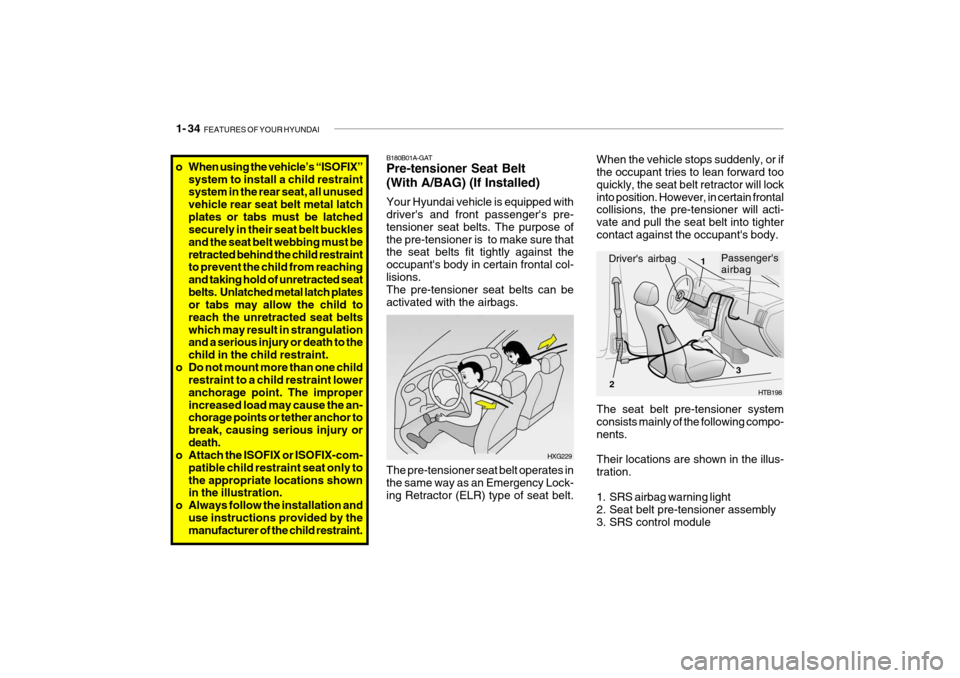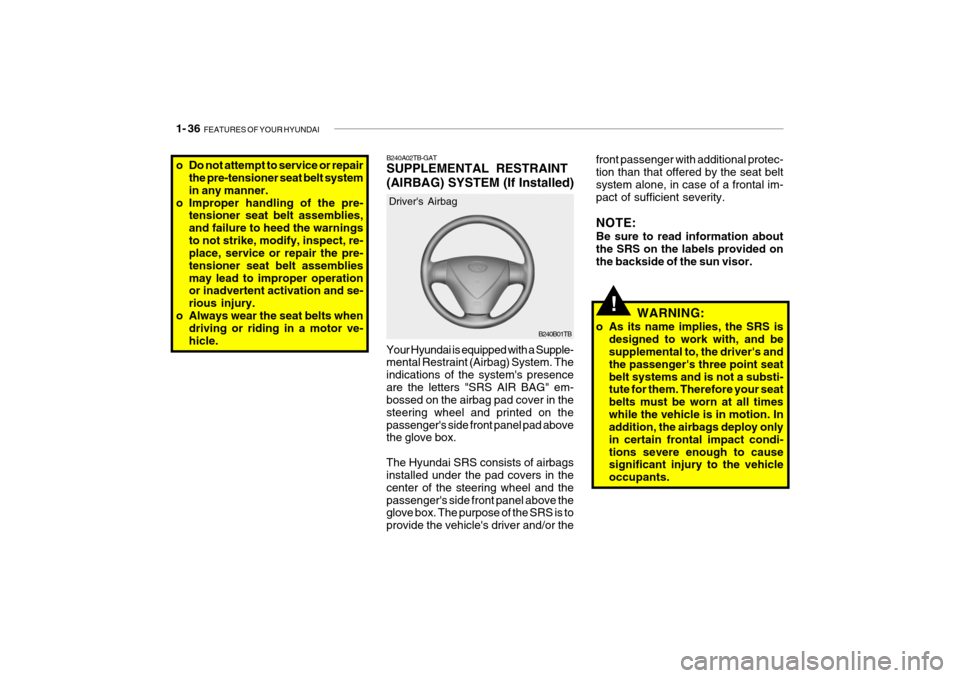Hyundai Getz 2007 Service Manual
Manufacturer: HYUNDAI, Model Year: 2007, Model line: Getz, Model: Hyundai Getz 2007Pages: 463, PDF Size: 11.14 MB
Page 41 of 463

FEATURES OF YOUR HYUNDAI 1- 29
o Never allow a child to stand up or
kneel on the seat.
o Never use an infant carrier or child safety seat that "hooks" over a seatback; it may not provide ad- equate security in an accident.
o Never allow a child to be held in a person's arms while they are in a moving vehicle, as this could re-sult in serious injury to the child in the event of an accident or a sudden stop. Holding a child in amoving vehicle does not provide the child with any means of pro- tection during an accident, even if the person holding the child is wearing a seat belt.
o If the child restaint seat is not anchored properly, the risk of achild being seriously injured or killed in a collision greatly in- creases.
B230G01TB
To install a child restraint system in the outboard rear seats, extend the shoul- der/lap belt from its retractor. Installthe child restraint system, buckle the seat belt and allow the seat belt to take up any slack. Make sure that the lapportion of the belt is tight around the child restraint system and the shoulder portion of the belt is positioned so thatit cannot interfere with the child's head or neck. After installation of the child restraint system, try to move it in alldirections to be sure the child restraint system is securely installed. B230G01A-GAT Child Restraint System Installa- tion on Outboard Rear Seats
WARNING:
Do not install any child restraint sys- tem in the front passenger seat. Should an accident occur and causethe passenger side airbag to deploy, it could severely injure or kill an infant or child seated in an infant orchild seat. Therefore, only use a child restraint system in the rear seat of your vehicle.
If you need to tighten the belt, pull more webbing toward the retractor. When you unbuckle the seat belt and allow it toretract, the retractor will automatically revert back to its normal seated pas- senger emergency locking usage con-dition. NOTE:
o Before installing the child re-
straint system, read the instruc- tions supplied by the child re- straint system manufacturer.
o If the seat belt does not operate as described, have the systemchecked immediately by yourauthorized Hyundai dealer.!
Page 42 of 463

1- 30 FEATURES OF YOUR HYUNDAI
U : Suitable for "universal" category restraints approved for use in this mass group UF :Suitable for forward-facing "universal" category restraints approved for the use in this mass group
L1 : Suitable for Bebe comfort ELIOS (E2 037014) approved for the use in this mass group
L2 : Suitable for PegPerego primo Viaggio (E13 030010) approved for the use in this mass group
L3 : Suitable for Bebe comfort iSEOS (E2 039014) approved for the use in this mass group
L4 : Suitable for GRACO Autobaby (E11 03.44.160) approved for the use in this mass group
L5 : Suitable for Romer Lord Plus (E1 03301136) approved for the use in this mass group
L6 : Suitable for Euro Kids Star (E1 03301127/E1 03301129) approved for the use in this mass group
L7 : Suitable for BeSafe iZi COMFORT (E4 03443206) approved for the use in this mass group
L8 : Suitable for MAXI-COSI Priori XP (E1 03301153) approved for the use in this mass group
L9 : Suitable for Bebe comfort HiPSOS(E2 031011) approved for the use in this mass group
L10 : Suitable for ROMER ISOFIX GR1 (E1 R44-03301133) approved for use in this mass group
X : Seat position not suitable for children in this mass group
B230H03TB-GAT Child Seat Restraint Suitability For Seat Position Using the Seatbelt Use child safety seats that have been officially approved and are appropriate for your children. When using the child safety se
ats,
refer to the following table.
Rear Center
Age GroupSeating Position
UX
L1, L2, L3, L4 UX
Rear Outboard
Front Passenger
0 : Up to 10 kg (0 ~ 9 months)0+ : Up to 13 kg(0 ~ 2 years)I : 9kg to 18kg(9 months ~ 4 years)II & III : 15kg to 36kg(4 ~ 12 years) L1, L2, L3, L4
L3, L5, L6, L7, L8
U, L10X
L6, L9 U F X
Page 43 of 463

FEATURES OF YOUR HYUNDAI 1- 31
B230E01TB
Back panel
Front of Vehicle
Attaching clip
Covering shelf
2. Remove the load space cover.
3. Connect the tether strap hook to the child restraint hook holder and tighten to secure the seat.
B230B01TB
B230B02A-GAT Using a Child Restraint System with "Tether Anchorage" Sys-tem For small children and babies, the use of a child seat or infant seat is stronglyrecommended. This child seat or infant seat should be of appropriate size for the child and should be installed inaccordance with the manufacturer's in- structions. It is further recommended that the seat be placed in the vehicle'srear seat since this can make an impor- tant contribution to safety. Your vehicle is provided with three child restrainthook holders for installing the child seat or infant seat. Spacer (10mm), Child Restraint Hook Holder
Holder Bolt (5/16"-30 mm) Washer, Conical Spring Holder, Child Restraint Hook
Retainer Washer B230E02FC-GAT Securing a Child Restraint Sys- tem with "Tether Anchorage"System Three child restraint hook holders are located on the vertical back panel. (behind rear bumper bar)
1. Route the child restraint seat strap
over the seatback. For vehicles with adjustable head- rests, route the tether strap under the headrest and between the head-rest posts, otherwise route the tether strap over the top of the seatback.
Page 44 of 463

1- 32 FEATURES OF YOUR HYUNDAI
!WARNING:
To install the Child Restraint Seat, for safety reasons the Seat should be positioned rearmost with theseatback in a vertical position, not reclined. B230D05E-GAT Using a Child Restraint System with "ISOFIX" System and"Tether Anchorage" System ISOFIX is a standardised method of fitting child seats that eliminates the need to use the standard adult seat beltto secure the seat in the vehicle. This enables a much more secure and posi- tive location with the added benefit ofeasier and quicker installation. An ISOFIX-seat can only be installed if it has vehicle-specific approval in ac- cordance with the requirements of ECE- R44. For your Hyundai, the HyundaiISOFIX GR1 / Hyundai Duo / Römer ISOFIX GR1 and the Römer Duo ISOFIX / Britax Duo ISOFIX is approved ac-
HTB193cording to the requirement ECE-R44. This seat has been tested extensively by Hyundai and is recommended foryour Hyundai. NOTE: At present, this seat is the only one complying with that provision. In case that other manufacturers will furnish proof of a respective certifi-cation, Hyundai is going to evaluate this seat carefully and will give a recommendation provided that seatcomplies to the law. Please ask your Hyundai dealer in this respect.
B230C01TB
ISOFIX Anchor
ISOFIX Anchor Indicator Button
Page 45 of 463

FEATURES OF YOUR HYUNDAI 1- 33
WARNING:
o Do not install a child restraint seat at the center of the rear seat using the vehicle's outboard rear seat ISOFIX anchors. The ISOFIX an-chors are only provided for the left and right outboard rear seating positions. Do not misuse theISOFIX anchors by attempting to attach a child restraint seat in the middle of the rear seat to the ISOFIXanchors. In a crash, the child re- straint seat ISOFIX attachments may not be strong enough to se-cure the child restraint seat prop- erly in the center of the rear seat and may break, causing seriousinjury or death.!
On each side of the rear seat, between the cushion and backrest, are located a pair of ISOFIX anchorage points to-gether with a top tether mounting on the luggage compartment. During the in- stalling, the seat has to be engaged atthe anchorage-points in a way you can hear it clicking (check by pulling!) and has to be fixed with the Top Tether-belton the belonging point in the luggage- compartment. The installing and the use of a child-seat has to be doneaccording to the installing-manual, which is added to the ISOFIX-seat. NOTE: An ISOFIX-child-seat can only be installed if the seat has a vehicle- specific approval according to ECE-R44. Before using the ISOFIX-child- seat, which was bought for another car, ask your Hyundai-dealer whetherthis seat-type is approved and rec- ommended for your Hyundai. B230C02TB
1. To engage the child restraint seat to the ISOFIX anchor, insert the child restraint seat latch into the ISOFIX anchor. Listen for the audible "click" sound.
To secure the child restraint seat2. Connect the tether strap hook to the
child restraint hook holder and tighten to secure the seat. Refer to "Secur-ing a Child Restraint System with the Tether Anchorage System" on page 1-31.
! CAUTION:
Do not allow the rear seat belt web- bing to get scratched or pinched bythe ISOFIX-seat latch and ISOFIX anchor during the installation.
Page 46 of 463

1- 34 FEATURES OF YOUR HYUNDAI
o When using the vehicle’s “ISOFIX”
system to install a child restraint system in the rear seat, all unused vehicle rear seat belt metal latchplates or tabs must be latched securely in their seat belt buckles and the seat belt webbing must beretracted behind the child restraint to prevent the child from reaching and taking hold of unretracted seat
belts. Unlatched metal latch plates or tabs may allow the child to reach the unretracted seat beltswhich may result in strangulation and a serious injury or death to the child in the child restraint.
o Do not mount more than one child restraint to a child restraint loweranchorage point. The improperincreased load may cause the an- chorage points or tether anchor to break, causing serious injury ordeath.
o Attach the ISOFIX or ISOFIX-com-
patible child restraint seat only tothe appropriate locations shown in the illustration.
o Always follow the installation and use instructions provided by themanufacturer of the child restraint. The pre-tensioner seat belt operates inthe same way as an Emergency Lock- ing Retractor (ELR) type of seat belt.
HXG229
B180B01A-GAT Pre-tensioner Seat Belt (With A/BAG) (If Installed) Your Hyundai vehicle is equipped with driver's and front passenger's pre- tensioner seat belts. The purpose ofthe pre-tensioner is to make sure that the seat belts fit tightly against the occupant's body in certain frontal col-lisions. The pre-tensioner seat belts can be activated with the airbags.
When the vehicle stops suddenly, or if the occupant tries to lean forward too quickly, the seat belt retractor will lockinto position. However, in certain frontal collisions, the pre-tensioner will acti- vate and pull the seat belt into tightercontact against the occupant's body.
The seat belt pre-tensioner system consists mainly of the following compo- nents. Their locations are shown in the illus- tration.
1. SRS airbag warning light
2. Seat belt pre-tensioner assembly
3. SRS control module
HTB198
Driver's airbag1
2 3Passenger's airbag
Page 47 of 463

FEATURES OF YOUR HYUNDAI 1- 35
illuminates while the vehicle is being driven, please have an au- thorized Hyundai dealer inspectthe pre-tensioner seat belt or SRS airbag system as soon as pos- sible.
WARNING:
o Pre-tensioners are designed to operate only one time. After acti- vation, pre-tensioner seat belts must be replaced. All seat belts, of any type, should always bereplaced after they have been worn during a collision.
o The pre-tensioner seat belt as- sembly mechanisms become hotduring activation. Do not touch the pre-tensioner seat belt as-semblies for several minutes af- ter they have been activated.
o Do not attempt to inspect or re-
place the pre-tensioner seat beltsyourself. This must be done by an authorized Hyundai dealer.
o Do not strike the pre-tensioner seat belt assemblies.!
WARNING:
To obtain maximum benefit from a pre-tensioner seat belt:
1. The seat belt must be worn cor- rectly.
2. The seat belt must be adjusted to
the correct position.!
NOTE:
o Both the driver's and frontpassenger's pre-tensioner seat belts will be activated in certain frontal collisions. The pre- tensioner seat belts can be acti-vated with the airbags. The pre- tensioners will be activated un- der these conditions even if theseat belts are not being worn at the time of the collision.
o When the pre-tensioner seat belts are activated, a loud noise maybe heard and fine dust, which may appear to be smoke, may bevisible in the passenger com- partment. These are normal op- erating conditions and are nothazardous. o Although it is harmless, the fine
dust may cause skin irritation andshould not be breathed for pro-longed periods. Wash your hands and face thoroughly after an acci- dent in which the pre-tensionerseat belts were activated.
! CAUTION:
o Because the sensor that activates the SRS airbag is connected with the pre-tensioner seat belt, the SRSairbag warning light on the instrument panel will blink for ap- proximately 6 seconds after theignition key has been turned to the "ON" position, and then it should turn off.
o If the pre-tensioner seat belt is not working properly, this warn-ing light will illuminate even ifthere is no malfunction of the SRS airbag system . If the SRS airbag warning light does notilluminate when the ignition key is turned to "ON", or if it remains illuminated after blinking for ap-proximately 6 seconds, or if it
Page 48 of 463

1- 36 FEATURES OF YOUR HYUNDAI
B240B01TB
Driver's Airbag
Your Hyundai is equipped with a Supple- mental Restraint (Airbag) System. The indications of the system's presenceare the letters "SRS AIR BAG" em- bossed on the airbag pad cover in the steering wheel and printed on thepassenger's side front panel pad above the glove box. The Hyundai SRS consists of airbags installed under the pad covers in the center of the steering wheel and thepassenger's side front panel above the glove box. The purpose of the SRS is to provide the vehicle's driver and/or the B240A02TB-GAT SUPPLEMENTAL RESTRAINT (AIRBAG) SYSTEM (If Installed)
o Do not attempt to service or repair
the pre-tensioner seat belt system in any manner.
o Improper handling of the pre- tensioner seat belt assemblies,and failure to heed the warningsto not strike, modify, inspect, re- place, service or repair the pre- tensioner seat belt assembliesmay lead to improper operation or inadvertent activation and se- rious injury.
o Always wear the seat belts when driving or riding in a motor ve-hicle.
front passenger with additional protec- tion than that offered by the seat belt system alone, in case of a frontal im-pact of sufficient severity. NOTE: Be sure to read information about the SRS on the labels provided on the backside of the sun visor.
WARNING:
o As its name implies, the SRS is designed to work with, and besupplemental to, the driver's and the passenger's three point seatbelt systems and is not a substi- tute for them. Therefore your seat belts must be worn at all timeswhile the vehicle is in motion. In addition, the airbags deploy only in certain frontal impact condi-tions severe enough to cause significant injury to the vehicle occupants.
!
Page 49 of 463

FEATURES OF YOUR HYUNDAI 1- 37
could be severely injured or killed by an airbag deployment in case of an accident.
o Do not allow children to ride in the front passenger seat. If olderchildren (teenagers and older)must ride in the front seat, make sure they are always properly belted and that the seat is movedback as far as possible.
o For maximum safety protection
in all types of crashes, all occu-pants including the driver should always wear their seat belts whether or not an airbag is alsoprovided at their seating posi- tion to minimize the risk of se- vere injury or death in the eventof a crash. Do not sit or lean unnecessarily close to the airbag while the vehicle is in motion.
o The SRS airbag system must de- ploy very rapidly to provide pro-tection in a crash. If an occupantis out of position because of not wearing a seat belt, the airbag may forcefully contact the occu-pant causing serious or fatal in- juries.
HTB203
Rear impact
Side Impact Rollover
o Front airbags are not intended to deploy in side-impact, rear-im- pact or rollover crashes. In addi-tion, airbags will not deploy in frontal crashes below the deploy- ment threshold speed.
o The SRS is designed to deploy the
airbags only when an impact issufficiently severe and when theimpact angle is less than 30° from the forward longitudinal axis of the vehicle and will not deploy inside, rear or rollover impacts. Ad- ditionally, the airbags will only deploy once. Thus, seat beltsmust be worn at all times. o The driver should sit back as far as
possible while still maintainingcontrol of the vehicle. If you aresitting too close to the airbag, it can cause death or serious injury when it inflates.
o No objects should be placed over or near the airbag modules onthe steering wheel, instrumentpanel, and the front passenger's panel above the glove box, because any such object couldcause harm if the vehicle is in a crash severe enough to cause the airbags to deploy.
o If the airbags deploy, they must be replaced by an authorizedHyundai dealer.
o Do not tamper with or discon- nect SRS wiring, or other com-ponents of the SRS system. Do-ing so could result in injury, due to accidental firing of the airbags or by rendering the SRS inopera-tive.
o Do not install a child restraint
system in the front passengerseat position. A child restraint system must never be placed in the front seat. The infant or child
Page 50 of 463

1- 38 FEATURES OF YOUR HYUNDAI
The SRS consists of the following com- ponents:
- Driver's Airbag Module
- Passenger's Airbag Module
- SRS Service Reminder Indicator (SRI)
- SRS Control Module (SRSCM)
The SRSCM continually monitors all elements while the ignition is "ON" to determine if a frontal or near-frontalimpact is severe enough to require airbag deployment.
B240B01FC-GAT SRS Components and Functions
B240B01L
B240B02L
The SRS service reminder indicator (SRI) on the instrument panel will blink for about 6 seconds after the ignitionkey is turned to the "ON" position or after the engine is started, after which the SRI should go out. The airbag modules are located both in the center of the steering wheel and in the front passenger's panel above theglove box. When the SRSCM detects a considerable impact to the front of the vehicle, it will automatically deploy theairbags.
B240B03L